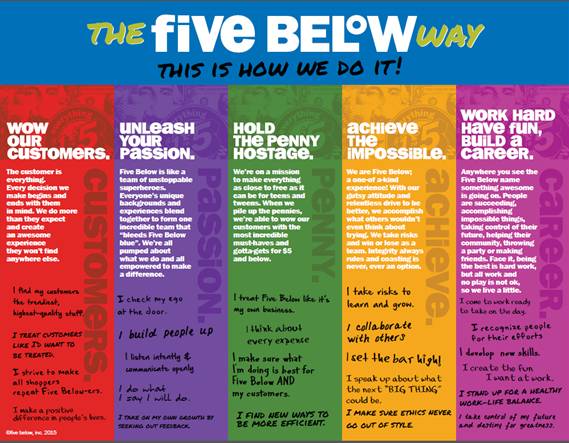Teens and pre-teens love going to a Five Below store. The retailer features an environment that is bright, colorful, fun, loud, and even chaotic.
Everything in the store sells at $5 or less (hence the name). Touching the merchandise is expected! Five Below stocks everything from smartphone accessories to sports equipment to remote control cars to candy to clothing — and nearly everything in between.
Five Below stores are a playland for pre-teens and teens. The company has figured out how to do the impossible: quickly identify the changing tastes of teens and provide quality products for under $5. Kids and their parents love the concept and have helped Five Below to succeed in a tough retail environment in 2016. The stock price increased 11% this June alone..
CEO Joel Anderson and the Five Below executive team are growing the business into new states, making the unique Five Below experience available to more of the over 60 million Americans between the ages of 9 and 19.
Five Below started in 2002 with one store in Philadelphia. Today, there are over 500 stores in 30 states, with more on the way.
Anderson and his team are aiming for 2,000 US stores. 2014 sales were at $680 million; executives believe they’re on track to hit $1 billion in sales by the end of 2016. Anderson, hired as president and chief operating officer in 2014 and promoted to CEO in 2015, is excited and optimistic about those growth targets.
The reason for his optimism? Culture. Anderson knows he and his executive team must formalize the unique Five Below culture so it effectively scales as the company adds stores, managers, and team members.
Success at Wal-Mart
Anderson experienced the benefits of a formalized culture while running a seven-state region for Wal-Mart in 2009-10. With 300 stores and over 85,000 associates, shifting the culture was a huge undertaking. Walmart measures performance metrics very effectively but, like many organizations, didn’t formalize values or behaviors. Anderson saw an opportunity to build cooperation, teamwork, and citizenship by focusing on values.
“You can’t leave your team culture to chance. Culture and values are too important to the business,” Joel said.
Joel and his regional leaders at Wal-Mart formed a steering committee that, with help from a consultant, crafted an organizational constitution which included a present-day servant purpose, values and behaviors, strategies, and goals. By defining desired values in measurable, observable, and behavioral terms, the team specified how all leaders and associates are expected to treat each other and customers, every day, in every interaction.
Joel said, “I believe people with passion drive performance. We had to remove employee frustrations and ensure all employees were treated with trust, respect, and dignity. We had to make values as important as results.”
He added, “Formalizing valued behaviors helped everyone know what was expected. Then we measured how well our leaders were modeling our valued behaviors every six months so people knew we were serious about it.”
The impact of the culture shift was significant. Within 12 months of the values initiative — and In the middle of a global recession — Anderson’s retail division saw 40% growth in employee engagement, 40% growth in customer service, and 35% gains in results and profits.
Bringing change to Five Below
In his new role, Anderson brought the culture process to Five Below. The same consultant worked with Bill Clark, senior vice president of human resources, and the Five Below culture committee to formalize their unique values and behaviors. With feedback from store associates and support staff, the committee identified five values, plus specific observable, measurable behaviors for each value.
Clark explained, “Maintaining a family-oriented, entrepreneurial culture when you’re growing so quickly isn’t easy. By getting to the core of our unique culture with these defined values and behaviors, new leaders and employees really ‘get’ what we’re all about.”
Five Below founders David Schlesinger and Tom Vellios believe the committee “really captured the heart and soul of Five Below.” These values have been part of the Five Below story from the beginning. They were known by long-time employees, but new employees didn’t understand the legacy. By formalizing these values and adding tangible behaviors, everyone knows what a great team member acts like and sounds like.
Joel and his senior leadership team members formally announced the values and behaviors at the company’s annual meeting last October. Leaders and employees have embraced them and are living them daily in their stores, in their distribution centers, and at the Philadelphia corporate offices.
Five Below associates recently completed the first values survey, which allows employees to rate their bosses on how well those leaders demonstrate Five Below’s values and behaviors. More than 70 percent of the targeted audience completed the survey. Functional teams are reviewing the data to outline successes, action plans, and follow up items.
Anderson says, “The only way we can maintain our unique, customer-driven culture is to define it, model it, and measure it as we grow.”
Don’t leave your team or department or company culture to chance. The proven path to a purposeful, positive, productive culture is to be specific about both performance and values then hold everyone accountable for both, every day.
How well defined are your company’s values? Are they observable, tangible, and measurable — as much so as performance metrics?
Subscribe to my free twice-a-month newsletter. Subscribers enjoy free resources including a preview of my Amazon best seller, The Culture Engine, which helps team and company leaders create a powerful, purposeful, positive, productive work environment. Podcast – Listen to this post now by clicking the podcast link at left. Subscribe via RSS or iTunes. The music heard on these podcasts is from one of my songs, “Heartfelt,” copyright © 2005-2016 Chris Edmonds Music (ASCAP). I played all instruments, recorded all tracks, and mixed the final product, just for you.
If you enjoyed this article, join SmartBrief’s e-mail list for our daily newsletter on being a better, smarter leader.
